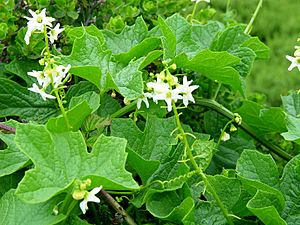Oregon manroot facts for kids
Quick facts for kids Oregon manroot |
|
|---|---|
 |
|
| Scientific classification | |
| Genus: |
Marah
|
| Species: |
oreganus
|
| Synonyms | |
|
Marah oregana |
|
Marah oreganus, also known as the Oregon manroot, coastal manroot, or western wild-cucumber, is a common plant found along the northwest coast of the United States. You can find it growing from California all the way north into Canada.
Contents
What Does the Oregon Manroot Look Like?
The coastal manroot has very smooth leaves, buds, and branches, especially compared to other plants in its family. Plants growing in colder, northern areas are almost completely hairless and have shiny leaves. Its long vines start to appear in late winter or early spring when there's more rain. These vines can climb or spread out up to 6 meters (about 20 feet) long!
The leaves usually have five main parts, called lobes. Even on the same plant, the size of the leaves and the length of their lobes can be very different. However, coastal manroot generally has larger leaves than other Marah species.
The Giant Root
These vines grow from a very large, hard root that looks like a tuber. This root can be several meters long and weigh more than 100 kilograms (over 220 pounds)! You might see these huge roots along roadsides or on hillsides where the soil has worn away. They have a scaly, tan surface. If a root gets hurt or starts to decay, it can turn a golden or orange color.
Manroot Flowers: Male and Female
The flowers of the coastal manroot can be yellowish-green, cream, or white. They start to appear soon after the vine emerges. This plant has special flowers because each flower is either male or female, but both types grow on the same plant. This is called being monoecious.
Male flowers grow in open clusters that look like spikes. Female flowers are easy to spot because they have a swollen base, and they usually grow one by one. The plant can fertilize itself, meaning pollen from its own male flowers can fertilize its female flowers. Insects help with this pollination process.
The Manroot's Spiky Fruit
The fruit of the coastal manroot is round, about 4–5 centimeters (1.5–2 inches) across. It's covered in prickles that can be up to 1 centimeter long, but they don't have hooks. When the fruit is young, it's bright green. As it ripens, it turns yellow. The fruit swells up until it finally bursts open, releasing its large seeds. Fruits start to form in spring and are ready in summer.
Life Cycle: Seeds and Sprouts
The seeds of the coastal manroot are big, hard, and smooth. Unlike the bullet-shaped seeds of other Marah plants, these seeds are flatter and look more like discs. Each fruit usually holds four or more seeds.
These seeds have a very interesting way of growing. When a seed first sprouts, the initial shoot grows downward into the ground. Then, this shoot splits into two parts. One part starts to swell and forms the large tuber (root). The other part grows back up to the surface and becomes the vine you see.
Important: The seeds are very poisonous and should never be eaten.
Where Does the Manroot Grow?
Coastal manroot grows best near streams or in wet areas, but it can also survive in drier places. It can be found at elevations up to 1600 meters (about 5250 feet). This plant can grow in many different types of soil and can handle various soil acidities. However, it always needs the soil to be at least a little bit wet during certain times of the year.
The vines can grow in full sunlight or in very shady conditions. In mild areas where there is moisture all year round, the vines are perennial, meaning they live for more than two years. In places with cold winters, the vines die back in the fall. In areas that have wet and dry seasons, the vines grow at the start of the wet season and then completely die back during the dry season.
What is the Manroot Used For?
All parts of the manroot plant taste very bitter. This is actually where its genus name, Marah, comes from, as it means "bitter" in Hebrew. The fruit is not safe to eat. The large tuber (root) of the manroot can be processed to create a substance that is similar to soap.
Traditional Uses by Native Americans
Marah oreganus was used by various Native American tribes for different health purposes.
- The Chinook tribe made a special paste, called a poultice, from the gourd.
- The Squaxin people would mash the upper part of the stalk in water and use it to soak aching hands.
- The Chehalis people would burn the root and mix the powder with bear grease. They then applied this mixture to skin sores, specifically those from a condition called scrofula.
- The Coast Salish people made a special liquid, called a decoction, from the plant. They used this to help with kidney problems and scrofula sores.
Images for kids





